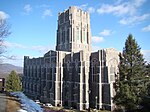The United States Military Academy (USMA), also known metonymically as West Point or simply as Army, is a United States service academy in West Point, New York. It was originally established as a fort, since it sits on strategic high ground overlooking the Hudson River with a scenic view, 50 miles (80 km) north of New York City. It is the oldest of the five American service academies and educates cadets for commissioning into the United States Army.
The academy was founded in 1802, one year after President Thomas Jefferson directed that plans be set in motion to establish it. The entire central campus is a national landmark and home to scores of historic sites, buildings, and monuments. The majority of the campus's Norman-style buildings are constructed from gray and black granite. The campus is a popular tourist destination, with a visitor center and the oldest museum in the United States Army.
Candidates for admission must apply directly to the academy and receive a nomination, usually from a member of Congress. Other nomination sources include the president and vice president. Students are officers-in-training and are referred to as "cadets" or collectively as the "United States Corps of Cadets" (USCC). The Army fully funds tuition for cadets in exchange for an active duty service obligation upon graduation. About 1,300 cadets enter the academy each July, with about 1,000 cadets graduating.
The academic program grants a Bachelor of Science degree with a curriculum that grades cadets' performance upon a broad academic program, military leadership performance, and mandatory participation in competitive athletics. Cadets are required to adhere to the Cadet Honor Code, which states that "a cadet will not lie, cheat, steal, or tolerate those who do." The academy bases a cadet's leadership experience as a development of all four pillars of performance: academics, character, physical, and military.
Most graduates are commissioned as second lieutenants in the Army. Foreign cadets are commissioned into the armies of their home countries. Since 1959, cadets have also been eligible for an interservice commission in one of the other armed services provided that they meet that service's eligibility standards. A small number of cadets do this.
The academy's traditions have influenced other institutions because of its age and unique mission. It was the first American college to have an accredited civil engineering program and the first to have class rings, and its technical curriculum became a model for engineering schools. West Point's student body has a unique rank structure and lexicon. All cadets reside on campus and dine together en masse on weekdays for lunch. The academy fields 15 men's and nine women's National Collegiate Athletic Association (NCAA) sports teams. Cadets compete in one sport every fall, winter, and spring season at the intramural, club, or intercollegiate level. Its football team was a national power in the early and mid-20th century, winning three national championships. Among the country's public institutions, the academy is the top producer of Marshall and Rhodes scholars. Its alumni and students are collectively referred to as "The Long Gray Line," the former include: U.S. Presidents Dwight D. Eisenhower and Ulysses S. Grant; Jefferson Davis of the Confederacy; Confederate general Robert E. Lee; American poet Edgar Allen Poe; U.S. general George Patton; presidents of Costa Rica, Nicaragua, and the Philippines; and 76 Medal of Honor recipients.









